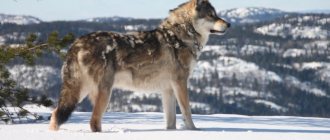Naturally, we will not talk about short-haired and decorative small domestic breeds, which can suffer from ordinary rain.
An experienced or at least a responsible owner, planning to get a dog that will live on the street and perform special security functions, always asks the person selling the puppy how this breed can withstand the harsh winter conditions. But, unfortunately, not everyone does this.
You can alleviate the condition of your four-legged dog by providing him with first aid:
- wrap your pet in a warm blanket, cover with heating pads (temperature 40 °C);
- drink warm tea with honey, milk, broth or a small amount of Cahors;
- do not rub frostbitten areas of the body, as these actions are associated with the risk of infection;
- Apply a cotton-gauze bandage to the resulting wounds.
The animal must then be taken to a veterinary clinic for resuscitation. Hypothermia is dangerous because internal organs suffer serious and even irreversible damage. After overcoming the threat to life, long-term treatment awaits.
[custom_ads_shortcode1]
Other winter hazards
Allergy to melting snow
Since the ecology in most cities leaves much to be desired, the snow that falls during the winter contains a huge amount of heavy metals and other harmful substances. When the snow begins to melt at the end of winter, all these substances are intensely released into the air, causing allergic reactions in some dogs. Signs of the disease, which is called “allergy to melting snow,” are coughing, sneezing, discharge from the eyes and nose, and sometimes changes in the skin are observed. If a dog develops such an allergy, you should immediately contact a veterinarian.
Electric shock
In winter, the electrical insulation of wires, metal surfaces of transformers, etc. deteriorates. Avoid contact of the dog with all kinds of “pieces of iron” on sidewalks, bridges and in public transport. If your dog suddenly starts shaking without moving, it could be an electric shock. You need to “pull” your pet from a dangerous place with a leash as quickly as possible.
Limit your time outside
First of all, you should consider the outside temperature and wind. The easiest way to keep most pets safe during the winter is to keep them outside. Veterinarians recommend keeping cats indoors year-round because they are at greater risk of infection, injury, and attacks from other animals when outdoors. For dogs, the advice is similar: they should stay indoors most of the day and night. But even if you need to walk your dog around the block for 5-10 minutes, you don't necessarily need to buy special clothes or shoes for this.
Do dogs' paws get cold in winter?
There is a scientific refutation of the opinion that dogs' paws get cold in winter and that they need winter shoes. The ancient ancestors of dogs lived in a harsh climate. Therefore, nature made sure that the paws, in contact with snow, ice, and cold earth, did not freeze.
The circulatory system in the limbs of dogs is designed in such a way that the blood does not have time to cool down. Veins and arteries are located close to each other, which ensures the heating of venous blood.
A much greater danger is posed by the “chemicals” and salts that are sprinkled on paths and streets. This is a real disaster for city dogs.
Symptoms of hypothermia and frostbite
With a mild degree of hypothermia, the dog experiences symptoms such as trembling and chills, it can shift from paw to paw or tuck them under itself, the mucous membranes begin to turn pale, and the body temperature drops. Normally, a dog's body temperature can fluctuate. In a puppy of any breed, an elevated temperature can most often be measured before the age of six months. It stays within 39 degrees. An adult dog has between 37.5 and 39. A dog's normal body temperature is between 38.3 and 39.
If you miss the first degree of hypothermia, the next degree of hypothermia occurs, which is characterized by a decrease in activity: the dog becomes lethargic, apathetic, muscles become stiff, low blood pressure appears, a stupor-like state, and slow, shallow breathing.
The most dangerous form of hypothermia is severe, when the dog begins to have problems with inhalation and exhalation, while the pupils dilate, the heart rate slows down, and loss of consciousness is possible.
As for frostbite, it most often affects peripheral areas of the body: paws and fingers, mammary glands, scrotum, ears. When frostbite occurs in these areas, sensitivity is reduced or completely absent, the skin changes color first to pale and then darkens, and blisters may appear.
Dog breeds for winter
If you live in a harsh climate with long, cold, snowy winters, you should think carefully before getting a dog.
Which breed should I prefer to keep in the yard and how to provide it with normal wintering conditions? What breeds can be kept indoors but taken on long walks? You should consult with a veterinarian on how to provide your dog with a nutritious diet and what preventive vaccinations need to be given, what vitamins to give so that the pet is healthy and has a strong immune system.
Did you know! Scientists have proven the fact that the larger the dog, the easier it tolerates the cold, the slower its body cools down.
The choice of long-haired large breeds that tolerate frost well in outdoor conditions is rich. Let's look at the most popular:
- Alabai is a Central Asian Shepherd Dog. Contents: an enclosure with a booth.
- The Husky is a large and powerful sled dog with a thick double coat. It is preferable to keep in an enclosure equipped with a booth. Many are kept indoors.
- The Malamute is a strong built and strong sledding breed. Can be kept on a leash, but the dog needs regular exercise during walks. Recently, the breed has become popular for home keeping.
- Moscow watchdog. Keeping: an enclosure with a booth, regular free walking.
- The Caucasian Shepherd is distinguished by a very thick coat and tolerance to cold. They are kept in enclosures and free to roam in the yard at night.
- German Shepherd. Can be kept on a leash, but better in an enclosure.
- West Siberian Laika. Can live on a leash and indoors, but needs a good run when young.
- The Samoyed is a medium-sized white dog with an original appearance, resembling a Spitz. You can keep it either in an enclosure with a warm booth or in a house.
Popular breeds that can withstand cold weather include Newfoundlands, Leonbergers, South Russian Shepherds, Tibetan Mastiffs, and St. Bernards. They are often kept by owners of country houses.
In this regard, medium and small dogs are much more convenient for an apartment: collie, bobtail, chow-chow. Long-haired poodles, spaniels, and dachshunds, at first glance, should not freeze. But due to their undercoat being underdeveloped, they need winter clothing for walking.
Don't think that a barn cat can cope with the cold easily
Outdoor cats spend a lot of time outdoors, but make no mistake that in winter they will find a warm place for themselves. Veterinarians often see cases of hypothermia and even frostbite in cats that are exposed to the cold for too long. Cats that live outside have thicker fur than indoor cats, but even this cannot completely protect them. During hypothermia, the cat's body directs blood from peripheral areas - such as the ears, nose, paws, tail - to the vital organs, that is, the kidneys, brain and heart. Frostbitten skin will appear pale or grayish, and in extreme cases may even turn black. A cat suffering from hypothermia may appear depressed or anxious, and will tremble and cry. It's also important to remember that cats sometimes try to find warmth near cars. This may cause injury when the engine starts running. Therefore, it is always important to check the car to make sure that there is no cat near it before starting it. Another danger for barn cats is that in frosty weather they have difficulty finding water. If your cat doesn't have access to water, this will become a real problem.
The main thing about caring for your dog in winter
A dog that can easily withstand cold, for keeping in the yard, is a large, moderately well-fed, healthy, young animal with a well-developed undercoat.
Even if a dog by nature can easily tolerate sub-zero temperatures, you cannot limit its movement by keeping it on a leash all the time. He must run, eat a hearty meal, have a warm booth and an enclosure with a wooden floor. The size of the kennel matters. The less extra space there is, the warmer the dog is. In particularly severe frosts, the animal should have the opportunity to spend the night indoors, dry out, and regain strength.
You cannot keep a whelping female with puppies in the cold. Keep the nest with babies and mother in a warm barn or room. If the puppies were born in cold weather and are kept in an unheated room, place a heating pad on them while the mother goes out for a walk.
During winter, many dogs are taken to the veterinary hospital for treatment. Most often, these are alarming symptoms associated with a long stay of the animal in the cold: sore throat, cough, hoarse voice, serious frostbite and injuries to the lower body, skin problems. All this is the result of the owner’s inattention to his pet.
It will take a lot of effort and money to restore the lost health of your four-legged friend. But isn't it better to take care of your dog in advance?
Make sure indoor cats stay indoors
Cat owners who follow veterinarians' advice and keep their cats indoors year-round may run into problems if their cats accidentally end up outside where they are not accustomed to being. Finding itself in an unfamiliar place, a cat may get scared and get lost. So make sure there is no chance of her escaping. If your cat is accustomed to coming and going as she pleases, check to see if she has returned home if you have to leave for work or go out on the town for the night. If you let her out in the morning and leave, she won't be able to come back.
Store antifreeze in a safe place
Antifreeze is a dangerous toxin that can threaten the health and lives of pets. Apparently, ethylene glycol, a substance that is contained in antifreeze, attracts cats and dogs. They may try to lick it if you forget to cap the bottle, or it may end up on the garage floor or driveway. Cats may also walk through these puddles and then lick their paws. Antifreeze is dangerous to animal health, as it impairs kidney function and affects the functioning of the nervous system. Also keep an eye out for these other household items that are dangerous for pets.











